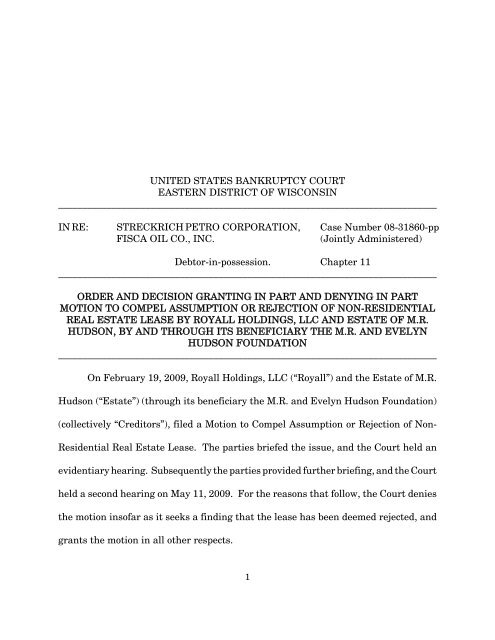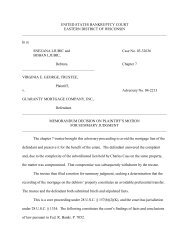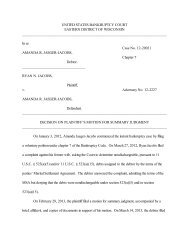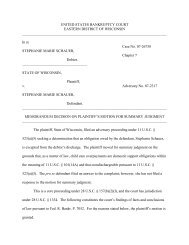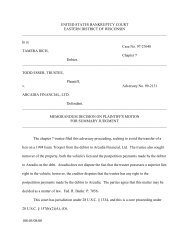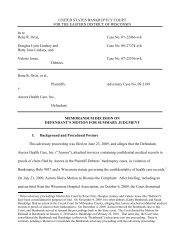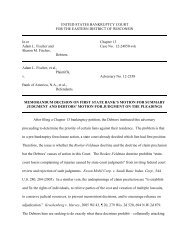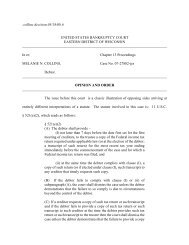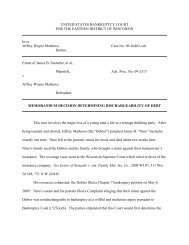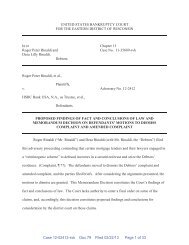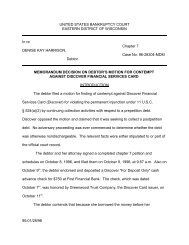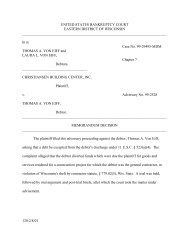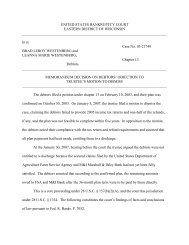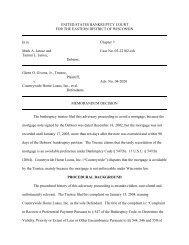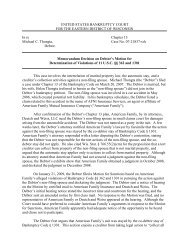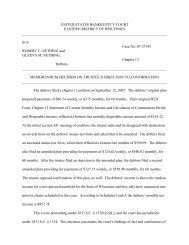In Re Streckrich Petro Corporation, 08-31860 - Eastern District of ...
In Re Streckrich Petro Corporation, 08-31860 - Eastern District of ...
In Re Streckrich Petro Corporation, 08-31860 - Eastern District of ...
Create successful ePaper yourself
Turn your PDF publications into a flip-book with our unique Google optimized e-Paper software.
UNITED STATES BANKRUPTCY COURT<br />
EASTERN DISTRICT OF WISCONSIN<br />
______________________________________________________________________________<br />
IN RE: STRECKRICH PETRO CORPORATION, Case Number <strong>08</strong>-<strong>31860</strong>-pp<br />
FISCA OIL CO., INC.<br />
(Jointly Administered)<br />
Debtor-in-possession. Chapter 11<br />
______________________________________________________________________________<br />
ORDER AND DECISION GRANTING IN PART AND DENYING IN PART<br />
MOTION TO COMPEL ASSUMPTION OR REJECTION OF NON-RESIDENTIAL<br />
REAL ESTATE LEASE BY ROYALL HOLDINGS, LLC AND ESTATE OF M.R.<br />
HUDSON, BY AND THROUGH ITS BENEFICIARY THE M.R. AND EVELYN<br />
HUDSON FOUNDATION<br />
______________________________________________________________________________<br />
On February 19, 2009, Royall Holdings, LLC (“Royall”) and the Estate <strong>of</strong> M.R.<br />
Hudson (“Estate”) (through its beneficiary the M.R. and Evelyn Hudson Foundation)<br />
(collectively “Creditors”), filed a Motion to Compel Assumption or <strong>Re</strong>jection <strong>of</strong> Non-<br />
<strong>Re</strong>sidential <strong>Re</strong>al Estate Lease. The parties briefed the issue, and the Court held an<br />
evidentiary hearing. Subsequently the parties provided further briefing, and the Court<br />
held a second hearing on May 11, 2009. For the reasons that follow, the Court denies<br />
the motion ins<strong>of</strong>ar as it seeks a finding that the lease has been deemed rejected, and<br />
grants the motion in all other respects.<br />
1
I. FACTUAL BACKGROUND<br />
A. The Stock Purchase Agreement and the Lease Agreement<br />
Fisca Oil Co., <strong>In</strong>c. (“Fisca”) is a company that operates nine gasoline and<br />
convenience stores in Ohio and Missouri, and owns and manages other real estate<br />
properties spread across four states. (Affidavit <strong>of</strong> Owen Richelieu III (“Richelieu Aff.”)<br />
5.) The Estate previously owned 100% <strong>of</strong> the common shares <strong>of</strong> Fisca. On or about<br />
December 26, 2006, the Estate entered into a Stock Purchase Agreement with<br />
<strong>Streckrich</strong> <strong>Petro</strong>leum LLC 1 (“<strong>Streckrich</strong> LLC”), wherein <strong>Streckrich</strong> LLC agreed to<br />
purchase all <strong>of</strong> the shares <strong>of</strong> Fisca. (Affidavit <strong>of</strong> John D. Hooser (“Hooser Aff.”), 3;<br />
Exhibit 1 to Creditors’ Motion to Compel Assumption or <strong>Re</strong>jection <strong>of</strong> Non-<strong>Re</strong>sidential<br />
<strong>Re</strong>al Estate Lease (“Stock Purchase Agreement”).)<br />
Although the parties entered into the Stock Purchase Agreement on December<br />
26, 2006, <strong>Streckrich</strong> LLC encountered difficulties financing the purchase, and those<br />
difficulties required the parties to re-negotiate the agreement. For reasons that the<br />
Court does not quite understand, but which are not germane to the topic at hand, the<br />
parties agreed that as a part <strong>of</strong> these re-negotiations, <strong>Streckrich</strong> LLC would form the<br />
<strong>Streckrich</strong> <strong>Petro</strong> <strong>Corporation</strong> (“SPC”) prior to closing the Stock Purchase Agreement.<br />
They further agreed that under that agreement, SPC would replace <strong>Streckrich</strong> LLC as<br />
the purchaser <strong>of</strong> the Fisca shares. Owen Richelieu III (“Richelieu”) and G. Paul<br />
1<br />
<strong>Streckrich</strong> <strong>Petro</strong>leum LLC should not be confused with the debtor-inpossession,<br />
<strong>Streckrich</strong> <strong>Petro</strong> <strong>Corporation</strong>. The two entities are separate, as the<br />
Court will discuss later in this opinion.<br />
2
Streckmann (“Streckmann”) are the principals <strong>of</strong> both <strong>Streckrich</strong> LLC and SPC.<br />
After extensive negotiations and several changes to the financing terms <strong>of</strong> the<br />
Stock Purchase Agreement, <strong>Streckrich</strong> LLC and the Estate executed an Addendum to<br />
Stock Purchase Agreement (“Addendum”), wherein they agreed that SPC would replace<br />
<strong>Streckrich</strong> LLC as purchaser under the Agreement. (Exhibit 2 to Creditors’ Motion to<br />
Compel Assumption or <strong>Re</strong>jection <strong>of</strong> Non-<strong>Re</strong>sidential <strong>Re</strong>al Estate Lease (“Ex. 2”), at 1.)<br />
The Addendum details all <strong>of</strong> the changes to the original Stock Purchase Agreement.<br />
Under the original Agreement, <strong>Streckrich</strong> LLC had agreed to pay “a nonrefundable<br />
earnest money deposit <strong>of</strong> $100,000,” and to pay a total purchase price <strong>of</strong><br />
$13,500,000.00. (Ex. 2 at 1.) The Addendum decreased the purchase price to<br />
$7,000,000.00. The Addendum specified that the payment <strong>of</strong> that purchase price was<br />
to be secured through several different instruments, including a Security Agreement<br />
granting the Estate a lien on all <strong>of</strong> Fisca’s shares and assets; a $2,000,000.00 cash<br />
payment at closing; and a $4,000,000.00 promissory note (the “$4 million note”). 2 (Ex.<br />
2 at 2.) SPC was to pay the final one million dollars <strong>of</strong> the purchase price by agreeing<br />
to Fisca’s distribution <strong>of</strong> a one million dollar dividend to the Estate, prior to Fisca’s sale<br />
to SPC. (Ex. 2 at 2; Richelieu Aff. at 10.)<br />
The Addendum further stated that if SPC failed to pay any <strong>of</strong> the $2 million in<br />
cash required at the closing, Fisca would distribute to the Estate, “as sole shareholder<br />
2<br />
SPC and Fisca entered into the $4 million note for the benefit <strong>of</strong> the Estate.<br />
(Exhibit 4 to Creditors’ Motion to Compel Assumption or <strong>Re</strong>jection <strong>of</strong> Non-<br />
<strong>Re</strong>sidential <strong>Re</strong>al Estate Lease (“Ex. 4) at 1.)<br />
3
<strong>of</strong> [Fisca], a dividend in the amount equal to the difference between the $2,000,000 and<br />
the amount <strong>of</strong> Closing Cash actually paid by [SPC] to [the Estate] by wire transfer as<br />
<strong>of</strong>” noon on the day <strong>of</strong> closing. (Ex. 2 at 1(B).) The Addendum further stated that<br />
concurrent with the Addendum, principals Richelieu and Streckmann would execute<br />
a $2 million promissory note (“$2 million note”) to the benefit <strong>of</strong> the Estate, to be<br />
effective at the time <strong>of</strong> closing. (Ex. 2 at 1(C).) The Estate would “apply to the then<br />
outstanding principle on the [$2 million note] (1) the amount <strong>of</strong> Closing Cash actually<br />
paid by [SPC] to [the Estate]; and (2) the amount <strong>of</strong> any dividend distributed by [Fisca]<br />
to [the Estate] to <strong>of</strong>fset Closing Cash owed but not paid” at the time <strong>of</strong> closing. (Ex. 2<br />
at 1(C).) The $2 million note was set to mature 30 days after closing, on April 11,<br />
20<strong>08</strong>. (Exhibit 3 to Creditors’ Motion to Compel Assumption or <strong>Re</strong>jection <strong>of</strong> Non-<br />
<strong>Re</strong>sidential <strong>Re</strong>al Estate Lease (“Ex. 3”), at 1.)<br />
<strong>In</strong> exchange for the lower purchase price, SPC agreed to take less than what it<br />
would have received under the original Stock Purchase Agreement. Pursuant to<br />
section 2.4 <strong>of</strong> the Addendum, the parties agreed that prior to its sale, Fisca would make<br />
a charitable contribution <strong>of</strong> four <strong>of</strong> Fisca’s real properties (“Four Properties”) to the<br />
M.R. and Evelyn Hudson Foundation, rather than selling those properties along with<br />
the Fisca stock, as it had planned to do in the original Stock Purchase Agreement. (Ex.<br />
2 at §2.4(A).) The Four Properties consisted <strong>of</strong> four gas stations and convenience<br />
stores, which account for 90% <strong>of</strong> Fisca’s revenues. (Richelieu Aff. 6.) The Estate<br />
agreed to form a new limited liability company, Royall Holdings, LLC (“Royall”), to<br />
4
hold the Four Properties. 3<br />
(Hooser Aff. 5b.) The Addendum states that SPC<br />
executed a Lease Agreement (“Agreement”) concurrently with the Addendum, and that<br />
Agreement was effective and delivered to the Estate at the time <strong>of</strong> closing. (Ex. 2 at<br />
1(F).) The Stock Purchase closed on March 11, 20<strong>08</strong>. (Hooser Aff. 7.) <strong>In</strong> essence,<br />
after the close <strong>of</strong> the Stock Purchase Agreement, SPC became a holding company<br />
whose only asset was 100% <strong>of</strong> the common stock <strong>of</strong> Fisca.<br />
Subsequent to these negotiations, Royall and SPC entered into the Agreement. 4<br />
(Exhibit 5 to Creditors’ Motion to Compel Assumption or <strong>Re</strong>jection <strong>of</strong> Non-<strong>Re</strong>sidential<br />
<strong>Re</strong>al Estate Lease (“Ex. 5”) at 1.) The Agreement allows SPC to use the Four<br />
Properties (previously owned by Fisca, but transferred to Royall prior to Fisca’s sale<br />
to SPC) to operate Fisca’s business. (Ex. 5 at 1; Ex. 5 at Ex. A.) <strong>In</strong> exchange for its use<br />
<strong>of</strong> the Four Properties, SPC agreed to pay rent as listed in the <strong>Re</strong>nt Addendum to the<br />
Agreement. (Ex. 5.) The Agreement also states that any default by Richelieu and<br />
Streckmann on the $2 million note, or by SPC and Fisca on the $4 million note, will be<br />
deemed to be a default under, and a breach <strong>of</strong>, the Agreement. (Ex. 5, §19.1(h) and (i).)<br />
The $2 million note matured on April 11, 20<strong>08</strong>, and Richelieu and Streckmann<br />
3 The Estate is the sole member <strong>of</strong> Royall. (Hooser Aff. 5b.)<br />
4 It is unclear when the parties actually entered into the Agreement. The<br />
Agreement stated that the “Effective Date” was January 1, 20<strong>08</strong>. The Agreement is<br />
dated March 11, 2007; however, the year appears to be a typographical error and it<br />
appears that the parties actually entered into the Agreement on March 11, 20<strong>08</strong>,<br />
the same day that the Stock Purchase closed. (Ex. 5., title page; §2.2.) <strong>In</strong> any<br />
event, the actual date is irrelevant to this analysis, and it is sufficient for our<br />
purposes to know that the parties had entered into the Agreement by March 11,<br />
20<strong>08</strong>.<br />
5
did not pay all <strong>of</strong> the amounts due under that note. (Hooser Aff. 10.) On April 21,<br />
20<strong>08</strong>, the Creditors notified Richelieu and Streckmann <strong>of</strong> their default under the $2<br />
million note, and notified SPC and Fisca <strong>of</strong> their default under the $4 million note (by<br />
virtue <strong>of</strong> the cross-default provisions in the $4 million note making the default under<br />
the $2 million note a default under the $4 million note). (Hooser Aff. 10.) The<br />
Creditors also notified SPC <strong>of</strong> its default under the Agreement as a result <strong>of</strong> the same<br />
cross-default provisions. (Hooser Aff. 10.) SPC also failed to pay the September and<br />
October 20<strong>08</strong> rents due to Royall under the Agreement. (Hooser Aff. 12.)<br />
B. The Bankruptcy Filings <strong>of</strong> the Debtors-in-Possession<br />
SPC filed Chapter 11 bankruptcy on October 29, 20<strong>08</strong>, and Fisca filed for<br />
Chapter 11 protection on February 12, 2009. These cases are being jointly<br />
administered, but have not been substantively consolidated. <strong>In</strong> Schedule G <strong>of</strong> its<br />
bankruptcy filing, SPC characterizes the Agreement as a “Property Lease dated March<br />
11, 20<strong>08</strong> on non-residential real property located in Missouri.” (Docket No. 10,<br />
Schedule G.) SPC has remained current with its post-petition payments under the<br />
Agreement. (Richelieu Aff. 2.)<br />
C. The Parties’ Positions<br />
The Creditors and SPC both have advanced numerous arguments concerning the<br />
Agreement.<br />
1. The Creditors’ initial arguments<br />
The Creditors argued that the Bankruptcy Code required SPC to assume or<br />
reject the Agreement within 120 days after filing its petition. The Creditors further<br />
6
argued that if SPC chose to assume the Agreement, the Code required it to cure any<br />
arrears due under the Agreement. According to the Creditors, the Agreement required<br />
SPC to pay not only all <strong>of</strong> the amounts due and owing under the Agreement, but also<br />
all the amounts due and owing under the $2 million note and the $4 million note, by<br />
virtue <strong>of</strong> the cross-default provisions in the Agreement. By Creditors’ calculation, the<br />
default under the Agreement was over five million dollars. The Creditors argued that<br />
the Code required SPC to pay that entire amount in order to cure the default under the<br />
Agreement.<br />
2. SPC’s initial arguments and Creditors’ response<br />
SPC responded by arguing that the Agreement was not a true lease, and<br />
therefore that 11 U.S.C. § 365 did not apply. According to SPC, the Agreement was an<br />
integral part <strong>of</strong> a larger transaction -- the Stock Purchase Agreement. <strong>In</strong> the<br />
alternative, SPC argued that if the Agreement was a lease, the amount the Creditors<br />
had requested for cure was disproportionate to the amount actually required to cure<br />
the defaults under the Agreement.<br />
During the time that the parties argued the Creditors’ motion, the 120th day<br />
since SPC filed its petition came and went. <strong>In</strong> their response to SPC’s objection, the<br />
Creditors advanced a new argument - that the language <strong>of</strong> § 365(d) required the Court<br />
to deem the lease to have been rejected because SPC had not assumed it within 120<br />
days <strong>of</strong> the date <strong>of</strong> filing.<br />
3. The evidentiary hearing<br />
At the evidentiary hearing, John Hooser, the Vice President <strong>of</strong> the M.R. and<br />
7
Evelyn Hudson Foundation (which is the sole Beneficiary <strong>of</strong> the Estate), testified. At<br />
the conclusion <strong>of</strong> the hearing, the Court indicated that it wanted (1) more information<br />
from the creditors regarding their assertion that a party could “re-characterize” a lease<br />
only by filing an adversary complaint, rather than in response to a motion; (2) more<br />
information from all <strong>of</strong> the parties regarding whether SPC’s response to the motion<br />
was, in fact, an attempt to re-characterize a lease; (3) more information on the question<br />
<strong>of</strong> whether the Agreement was a lease or a security agreement; (4) more information<br />
on whether, if the Agreement was a lease, failure to assume the lease constituted<br />
rejection; and (5) if not, argument on acceptable cures. The parties supplied further<br />
briefing on these issues.<br />
4. The additional arguments supplied upon further briefing<br />
The Creditors argued that SPC was attempting to re-characterize the<br />
Agreement, and that it could do so only via an adversary complaint. SPC argued that<br />
it was not attempting to re-charcterize a lease as something different, but rather that<br />
it was asserting in the first instance that the Agreement was not a lease.<br />
The Creditors argued that the Agreement was a true lease, and that the<br />
majority <strong>of</strong> courts had held that state law controls the issue <strong>of</strong> whether a document is<br />
a true lease. The Creditors noted that the Agreement stated that Missouri law<br />
controlled any disputes under the Agreement; therefore, they argued that Missouri law<br />
controlled the lease determination issue. The Creditors pointed out numerous<br />
provisions in the Agreement that supported their claim that the Agreement was a<br />
lease.<br />
8
SPC responded that, if the Agreement “is not a bona fide lease subject to §<br />
365(d)(4), it does not follow that the resulting relationship must be one with the<br />
earmarks <strong>of</strong> a disguised security agreement.” (Docket No. 55 at 6.) SPC argued that<br />
the Agreement “is more appropriately analyzed under the Economic Substance test<br />
requiring consideration <strong>of</strong> all facts and circumstances.” (Docket No. 55 at 7.) SPC<br />
opined that “the facts and circumstances surrounding the Stock Purchase Agreement<br />
[show] . . . that this Lease Agreement is not a bona fide lease . . . but rather is a debt<br />
instrument integrated with the Stock Purchase Agreement and the various Notes and<br />
serves to create . . . a seller-backed loan to allow the transaction to conclude.” (Docket<br />
No. 55 at 7.)<br />
5. The Court’s decision at oral argument<br />
The Court heard further argument on May 11, 2009. At that hearing, the Court<br />
orally held that SPC did not need to file an adversary proceeding in order to argue that<br />
the Agreement was not a true lease. The Court further determined that SPC’s<br />
argument was not an attempt to “recharacterize” the lease - it simply was a defense to<br />
the Creditor’s motion to compel SPC to assume or reject the lease. The Court concluded<br />
that the issue <strong>of</strong> whether the Agreement constituted a true lease was an issue that<br />
properly was before the Court and was ripe for decision.<br />
It is that issue to which the Court now turns its attention.<br />
II.<br />
JURISDICTION<br />
The issues in this case involve core proceedings under 28 U.S.C. § 157(b), and<br />
this Court has jurisdiction under 28 U.S.C. § 1334(b).<br />
9
III.<br />
LEGAL ANALYSIS<br />
A..<br />
The Agreement is a True Lease<br />
1. The Bankruptcy Code requires SPC to assume or reject the Agreement only<br />
if the Agreement is a true lease for non-residential real property.<br />
Because it is SPC who argues that the Agreement is not a true lease, it is SPC<br />
who has the burden <strong>of</strong> proving that proposition. “As the one contending the agreement<br />
is something other than what it purports to be, the plaintiff bears the burden <strong>of</strong><br />
proving that it is a disguised security interest rather than a lease.” <strong>In</strong> re Brankle<br />
Brokerage & Leasing, <strong>In</strong>c., 394 B.R. 906, 909 (Bankr. N.D.<strong>In</strong>d. 20<strong>08</strong>) (citing <strong>In</strong> re<br />
Pillowtex, <strong>In</strong>c., 349 F.3d 711, 717 (3rd Cir.2003); <strong>In</strong> re QDS Components, <strong>In</strong>c., 292 B.R.<br />
313, 321 (Bankr.S.D.Ohio 2002); Auburndale State Bank v. Dairy Farm Leasing Corp.,<br />
890 F.2d 888, 893 (7th Cir.1989)).<br />
This issue was joined when the Creditors filed a motion to force SPC to assume<br />
or reject the Agreement under 11 U.S.C. § 365. Section 365(a) states that “the trustee,<br />
subject to the court’s approval, may assume or reject any . . . unexpired lease <strong>of</strong> the<br />
debtor.” Subsection (d)(4) <strong>of</strong> 365 states:<br />
(4)(A) Subject to subparagraph (B), an unexpired lease <strong>of</strong> nonresidential<br />
real property under which the debtor is the lessee shall be deemed<br />
rejected, and the trustee shall immediately surrender that nonresidential<br />
real property to the lessor, if the trustee does not assume or reject the<br />
unexpired lease by the earlier <strong>of</strong>--<br />
(i) the date that is 120 days after the date <strong>of</strong> the order for relief;<br />
. . .<br />
(B)(i) The court may extend the period determined under subparagraph<br />
(A), prior to the expiration <strong>of</strong> the 120-day period, for 90 days on the<br />
motion <strong>of</strong> the trustee or lessor for cause.<br />
10
11 U.S.C. §365(d)(4).<br />
SPC, as debtor-in-possession, has the authority to assume or reject a<br />
nonresidential lease just as a trustee could under §365(d)(4). See, 11 U.S.C. § 1107(a)<br />
(a debtor-in-possession has “all the rights . . . and powers, and shall perform all the<br />
functions and duties . . . <strong>of</strong> a trustee serving in a case under” Chapter 11).<br />
Section 365(d)(4) requires SPC to assume or reject the Agreement only if the<br />
Agreement is “an unexpired lease <strong>of</strong> nonresidential real property.” There is no dispute<br />
that the Four Properties at issue are gas stations and convenience stores in Missouri,<br />
and thus are non-residential real properties. (Ex. A to Ex. 5.) To determine whether<br />
§ 365(d)(4) requires SPC to assume or reject the Agreement, then, the Court must<br />
determine whether the Agreement constitutes an “unexpired lease,” as the Creditors<br />
contend, or whether it is something else.<br />
2. State law governs whether the Agreement is a true lease.<br />
State law controls whether the lease is a “true lease” or a security agreement in<br />
the Seventh Circuit. <strong>In</strong> United Airlines <strong>In</strong>c. v. HSBC Bank USA, N.A., the Seventh<br />
Circuit held:<br />
Because nothing in the Bankruptcy Code says which economic features<br />
<strong>of</strong> a transaction have what consequences, we turn to state law. All <strong>of</strong> the<br />
states have devoted substantial efforts to differentiating leases from<br />
secured credit in commercial and banking law. Leases are state-law<br />
instruments, after all, and the norm in bankruptcy law is that contracts<br />
(<strong>of</strong> which leases are a species) and property rights in general have the<br />
same force they would have in state court, unless the Code overrides the<br />
state entitlement.<br />
416 F.3d 609, 615 (7th Cir. 2005) cert. denied, 547 U.S. 1003, 126 S.Ct. 1465, 164<br />
11
L.Ed.2d 247 (2006).<br />
<strong>In</strong> this case the Agreement states that it is governed by Missouri law. (See Ex.<br />
5 at § 23.13.) Therefore, the Court must look to Missouri law to determine whether the<br />
lease is a true lease or a security agreement.<br />
3. Missouri law directs the Court to look to the totality <strong>of</strong> the circumstances<br />
to determine whether the Agreement is a lease.<br />
<strong>In</strong> Pummill v. McGivern (<strong>In</strong> re American Eagle Coatings, <strong>In</strong>c.), 353 B.R. 656, 660<br />
(Bankr. W.D.Mo. 2006), the trustee filed an adversary case seeking, among other<br />
things, the recovery <strong>of</strong> “the value <strong>of</strong> the real property leased by Debtor under the<br />
theory that the lease was a disguised financing arrangement.” The trustee argued that<br />
the federal common law “economic realities test” was the appropriate test to use to<br />
determine whether the agreement was a true lease. The court noted, however, that the<br />
Seventh Circuit recently had decided United Airlines and had concluded that state law<br />
governed the determination <strong>of</strong> whether an agreement was a true lease unless that<br />
state’s law is in conflict with the Bankruptcy Code. Thus, the Pummill court looked<br />
to Missouri law, and held that in order to determine whether an agreement was a true<br />
lease, the court “should look at the totality <strong>of</strong> the circumstances <strong>of</strong> the transaction.”<br />
Id. at 668.<br />
The Pummill court stated that “[i]t has been held that the pivotal factor in<br />
determining whether an instrument is a true lease or security agreement is whether<br />
or not the lessee has an absolute obligation to purchase the property.” Id. (citing <strong>In</strong> re<br />
Hoskins, 266 B.R. 154 (Bankr.W.D.Mo.2001) and cases cited therein.) The court also<br />
12
discussed other factors that a majority <strong>of</strong> courts had considered when determining<br />
whether an agreement is a lease, including:<br />
whether the lessee has a purchase option at the end and, if so, whether<br />
the option price is nominal; whether the aggregate rental payments have<br />
a present value equal to or in excess <strong>of</strong> the original cost <strong>of</strong> the leased<br />
property; and whether the lease term covers the useful life <strong>of</strong> the<br />
property.<br />
Id. at 668 (citing <strong>In</strong> re <strong>In</strong>tegrated Health Services, <strong>In</strong>c., 260 B.R. 71<br />
(Bankr.D.Del.2001). The Pummill decision demonstrates that, under Missouri law,<br />
this Court must look to the totality <strong>of</strong> the circumstances to determine whether the<br />
Agreement is a true lease.<br />
4. The totality <strong>of</strong> the circumstances supports a finding that the Agreement is<br />
a true lease.<br />
The Pummill court held that the “substance <strong>of</strong> the transaction,” and not its form,<br />
controlled the determination <strong>of</strong> whether the transaction constituted a lease. Id.<br />
Accordingly, the fact that the parties in this case labeled the Agreement a “lease” is not<br />
dispositive <strong>of</strong> the inquiry. A review <strong>of</strong> the totality <strong>of</strong> the circumstances in this case,<br />
however, leads the Court to conclude that the Agreement is a true lease, such that it<br />
falls under the purview <strong>of</strong> section 365.<br />
a. The Agreement does not include an absolute obligation to purchase<br />
any <strong>of</strong> the Four Properties<br />
As stated in Pummill, “the pivotal factor in determining whether an instrument<br />
is a true lease or a security agreement is whether or not the lessee has an absolute<br />
obligation to purchase the property.” 353 B.R. at 668. <strong>In</strong> this case, the Agreement<br />
does not include an absolute obligation to purchase the property, either during or at<br />
13
the end <strong>of</strong> the specified term.<br />
Several portions <strong>of</strong> the Agreement confirm that SPC does not have an absolute<br />
obligation to purchase the property, and that SPC may terminate the Agreement<br />
without being required to purchase the property. First, section 17.1 states that<br />
“[t]enant shall, on or before the last day <strong>of</strong> the Term <strong>of</strong> this Lease or upon the sooner<br />
termination there<strong>of</strong>, peaceably and quietly surrender and deliver to Landlord the<br />
Premises . . . in good order, condition and repair . . . .” (Ex. 5 at §17.1) If the<br />
Agreement was meant to obligate SPC to purchase the property, then it would not<br />
require SPC to “peaceably and quietly surrender and deliver” the premises to Royall<br />
on or before the last day <strong>of</strong> the term <strong>of</strong> the Agreement.<br />
Second, under section 19.2, upon the occurrence <strong>of</strong> any event <strong>of</strong> default (as<br />
defined in the Agreement), Royall may terminate the Agreement “and, peaceably or<br />
pursuant to appropriate legal proceedings, re-enter, retake and resume possession <strong>of</strong><br />
the premises for Landlord’s own account.” (Ex. 5 at § 19.2(a).) Once Royall gives SPC<br />
written notice that the Agreement has been terminated, the “Lease shall cease and<br />
expire” and SPC “shall surrender the Premises to the Landlord.” (Ex. 5 at § 19.2(a).)<br />
If Royall terminates the Agreement due to an event <strong>of</strong> default, the Agreement still<br />
requires SPC to pay all rent and any other amounts due under the Agreement. (Ex.<br />
5 at §19.2(a).)<br />
Third, Article XX <strong>of</strong> the Agreement provides SPC with an option to purchase the<br />
property at either (1) the expiration <strong>of</strong> the term <strong>of</strong> the Agreement (provided that there<br />
has been no default and that the $2 million and $4 million notes have been paid in<br />
14
full); or (2) whenever the $2 million and $4 million notes have been paid in full. (Ex.<br />
5 at §20.1(a).) To exercise the option to purchase, SPC must give Royall written notice<br />
at least ninety (90) days (1) prior to the expiration <strong>of</strong> the term or (2) following<br />
repayment <strong>of</strong> both notes. (Ex. 5 at §20.1(b).) Article XX does not require SPC to<br />
purchase the properties; rather, it simply gives SPC the option to do so.<br />
Fourth, and similarly, Article XXI states that the Landlord grants the tenant the<br />
right <strong>of</strong> first refusal to purchase the Four Properties “at a price and on terms which<br />
shall be the same as <strong>of</strong>fered for the Premises in an ‘Offer to Purchase’ which is<br />
acceptable” to Royall. To exercise that right, SPC must provide an <strong>of</strong>fer to purchase<br />
on the same conditions and price as any <strong>of</strong>fer Royall receives, within 30 days <strong>of</strong> being<br />
given written notice <strong>of</strong> Royall’s receipt <strong>of</strong> said <strong>of</strong>fer. (Ex. 5 at Art. XXI.) Again, Article<br />
XXI does not require SPC to purchase the properties; rather, it simply grants SPC the<br />
right to submit an identical <strong>of</strong>fer if Royall receives a third-party <strong>of</strong>fer to purchase the<br />
properties during the course <strong>of</strong> the Agreement. If SPC does not submit an identical<br />
<strong>of</strong>fer within 30 days <strong>of</strong> receiving written notice from Royall, the right <strong>of</strong> first refusal is<br />
void, and Royall is free to accept the third-party <strong>of</strong>fer.<br />
Fifth, section 2.4 states that SPC has the option to renew the lease for an<br />
additional five years, and that it can do so up to four times. The renewal is automatic<br />
unless SPC provides Royall with 180 days’ written notice, prior to the expiration <strong>of</strong> the<br />
term, <strong>of</strong> its intent not to renew. SPC may not exercise the renewal option if (1) it is in<br />
default under the Agreement at the time <strong>of</strong> renewal and (2) it has not cured such<br />
default. (Ex. 5 at §2.4.) Section 2.4 is clear: “If Tenant shall fail, or shall not be<br />
15
entitled pursuant to the preceding sentence, to extend the Term <strong>of</strong> this Lease for an<br />
additional Option Period, all remaining rights <strong>of</strong> renewal shall automatically expire.”<br />
(Ex. 5 at §2.4.) Once the renewal rights expire, the Agreement provides that it<br />
concludes at the end <strong>of</strong> the current term, at which point SPC becomes obligated to<br />
peaceably and quietly surrender the premises pursuant to section 19.2.<br />
Sixth, section 11.3 states that if the Four Properties are<br />
damaged or destroyed by any <strong>of</strong> the casualties described in Section 11.1<br />
to the extent that the Premises are untenantable or unsuitable, in<br />
Tenant’s reasonable opinion, for continued use in the normal conduct <strong>of</strong><br />
Tenant’s business, Tenant shall have the right, exercisable by written<br />
notice to Landlord given within thirty (30) days after the date <strong>of</strong> such<br />
damage or destruction, to terminate this Lease effective upon the date <strong>of</strong><br />
such damage or destruction.<br />
(Ex. 5 at §11.3.) So, in the event that the premises are damaged or destroyed by<br />
casualty, § 11.3 provides that SPC can terminate the Agreement so long as (1) the<br />
destruction or damage was insured by SPC for the full replacement cost; (2) the insurer<br />
has confirmed that the coverage exists; and, (3) the insurer has confirmed that it is<br />
obligated to pay for the damages under the insurance policy. (Ex. 5 at §11.3.) Again -<br />
the Agreement does not require SPC to purchase the properties in order to terminate<br />
the Agreement.<br />
Similarly, section 12.1 states that, in the event that the “whole Premises or any<br />
material part <strong>of</strong> the building or material portion <strong>of</strong> the Land” is taken or condemned,<br />
or if SPC can demonstrate that the Properties cannot be “pr<strong>of</strong>itably operated” as a gas<br />
station and convenience store, or if SPC can demonstrate that there is no longer<br />
“reasonable access to the adjacent roadways from the existing or comparable curb cuts”<br />
16
as the result <strong>of</strong> a taking, then SPC may terminate the Agreement. (Ex. 5 at §12.1.)<br />
The Agreement does not require SPC to purchase the property if such events occur —<br />
it simply permits SPC to terminate the Agreement.<br />
As all <strong>of</strong> these provisions demonstrate, SPC did not have an absolute obligation,<br />
or indeed any obligation, to purchase the Four Properties, either during or at the end<br />
<strong>of</strong> the specified term. The Agreement provided SPC with the option to purchase, but<br />
it made clear that if SPC did not exercise the option, and did not renew the lease term,<br />
the premises would revert back to Royall. The absence <strong>of</strong> an absolute obligation to<br />
purchase weighs in favor <strong>of</strong> the conclusion that the Agreement is a true lease.<br />
b. The option price is not nominal.<br />
Another factor the Pummill court considered was “whether the lessee has a<br />
purchase option at the end and, if so, whether the option price is nominal.” 353 B.R.<br />
at 668. As discussed above, the Agreement does contain a purchase option. Under<br />
section 20.1 <strong>of</strong> the Agreement, SPC may purchase the property - either at the end <strong>of</strong><br />
the term, if no default has occurred and if it has paid the $2 million and the $4 million<br />
notes in full, or at any time after the $2 million and $4 million notes have been paid<br />
in full.<br />
For SPC to exercise the purchase option, the Agreement requires SPC to pay the<br />
greater <strong>of</strong> (1) five million dollars; or (2)<br />
[t]he average <strong>of</strong> appraised value <strong>of</strong> the Premises as determined by two<br />
qualified appraisers, one selected by [Royall] and the other by [SPC],<br />
provided that the difference between those two appraisals does not exceed<br />
15%. If the difference. . . exceeds 15%, said appraisers shall select a third<br />
appraiser to appraise the value <strong>of</strong> the Premises, and the Purchase Price<br />
17
shall be the average <strong>of</strong> all three (3) appraised values.<br />
(Ex. 5 at §20.1(c).) The Agreement provides that Royall and SPC also may agree to an<br />
alternate price if they so choose.<br />
So -- to exercise the purchase option, the Agreement states that SPC must pay<br />
the greater <strong>of</strong> five million dollars or the average <strong>of</strong> several appraised values. Neither<br />
<strong>of</strong> these two possible option prices is nominal - a factor which also weighs in favor <strong>of</strong><br />
the conclusion that the Agreement is a true lease.<br />
c. The term <strong>of</strong> the Agreement does not cover the useful life <strong>of</strong> the<br />
property.<br />
Another factor to consider when looking at the totality <strong>of</strong> the circumstances is<br />
“whether the lease term covers the useful life <strong>of</strong> the property.” Pummill, 353 B.R. at<br />
668. <strong>In</strong> the present case, the “property” consists <strong>of</strong> gas stations and convenience stores.<br />
The term <strong>of</strong> the Agreement is twenty years, with the option <strong>of</strong> extending the term for<br />
a maximum <strong>of</strong> twenty years. Although there was no testimony as to the age <strong>of</strong> any <strong>of</strong><br />
the gas stations, it does not appear likely that the 20-year term covers the useful life<br />
<strong>of</strong> such property. The properties at issue are buildings that will continue to be useful<br />
long after the term <strong>of</strong> the Agreement has ended, even assuming that the Agreement<br />
is extended four times. Again, this fact weighs in favor <strong>of</strong> a conclusion that the<br />
Agreement is a true lease.<br />
18
d. The remaining facts support a finding that the Agreement is a true<br />
lease.<br />
i. The parties appear to have intended the Agreement to be a<br />
lease agreement.<br />
As noted in Pummill, “Missouri cases look at the intent <strong>of</strong> the parties which can<br />
be determined from a consideration <strong>of</strong> the entire instrument, and the circumstances<br />
under which it was made.” Id.<br />
SPC argues that the primary purpose <strong>of</strong> the<br />
Agreement<br />
was not to find a tenant for the <strong>In</strong>come Producing Properties but to create<br />
a device to transfer cash to the Estate in exchange for the Fisca stock . .<br />
. When $4.5 million <strong>of</strong> cash was not available from [third party financier]<br />
Servant to pay to the Estate to conclude the stock purchase, the Estate<br />
created substitute financing to accomplish the same result. The economic<br />
substance <strong>of</strong> the Lease Agreement was at all times to create a loan to<br />
allow the Estate to conclude the Stock Purchase.<br />
(Docket No. 55 at 4-5.) SPC further argues that<br />
The Estate’s representatives knew that the <strong>In</strong>come Producing Stores<br />
were going to be operated, possessed and controlled by Fisca, knew that<br />
any arrangement with <strong>Streckrich</strong> in relation to the <strong>In</strong>come Producing<br />
Stores was solely for the use and benefit <strong>of</strong> Fisca and knew that payments<br />
could only be satisfied from and by Fisca. As a result, the facts and<br />
circumstances surrounding the Stock Purchase Agreement requires [sic]<br />
a determination that this Lease Agreement is not a bona fide lease<br />
subject to the requirements <strong>of</strong> §365(d)(4) but rather is a debt instrument<br />
integrated with the Stock Purchase Agreement and the various Notes and<br />
serves to create and identify a seller-backed loan to allow the transaction<br />
to conclude.<br />
(Docket No. 55 at 7.)<br />
Although SPC argues that the parties intended that the Agreement be a “debt<br />
instrument” to allow the Stock Purchase Agreement to conclude, other circumstances<br />
in the case, and various provisions in the Agreement, contradict this assertion. If SPC<br />
19
truly believed that the Agreement was a loan agreement, one would expect that it<br />
would list Royall on Schedule D as a creditor holding a secured claim. It did not do so.<br />
Rather, it listed the Agreement on Schedule G as a “Property Lease dated March 11,<br />
20<strong>08</strong> on non-residential real property located in Missouri.” (Docket No. 10, Schedule<br />
G.) Schedule G requires a debtor to describe all “unexpired leases <strong>of</strong> real or personal<br />
property.” SPC itself, therefore, characterized the Agreement as a lease agreement as<br />
late as November 13, 20<strong>08</strong> when it filed its bankruptcy schedules. 5<br />
<strong>In</strong> addition, the Agreement states that the parties “agree and acknowledge that<br />
this transaction is not intended as a security arrangement or financing secured by real<br />
property, but shall be construed for all purposes as a true lease.” (Ex. 5 at § 23.18.)<br />
While the form <strong>of</strong> the agreement does not control, this section specifically states that<br />
the parties intended for the Agreement to be a lease agreement and not a financing or<br />
security agreement. This, and the fact that SPC characterized the Agreement as a<br />
lease as late as November 13, 20<strong>08</strong>, provides persuasive support for the conclusion that<br />
the parties intended the Agreement to be a lease.<br />
ii.<br />
Many other provisions in the Agreement demonstrate that<br />
it is a lease agreement.<br />
The Agreement contains a number <strong>of</strong> other provisions that are similar to true<br />
lease provisions, including provisions permitting Royall the right to enter the<br />
5 <strong>In</strong> addition, in its motion for an order extending the exclusivity period for<br />
filing a plan <strong>of</strong> reorganization and to solicit acceptances there<strong>of</strong>, SPC stated that it<br />
was a holding company with an interest in a “Lease Agreement,” and that it was<br />
the tenant and Royall was the Landlord in that lease agreement. (Docket No. 26 at<br />
2.)<br />
20
properties upon reasonable notice to inspect the properties (Ex. 5 at Art. XIII);<br />
provisions prohibiting SPC from subletting the properties or assigning its rights under<br />
the Agreement without Royall’s prior written approval (Ex. 5 at Art. XIV); and<br />
provisions requiring SPC to obtain prior written consent from Royall before making<br />
any “additions, alteration or removals to the Premises which [SPC] believes reasonably<br />
beneficial to Tenant’s business” that are in excess <strong>of</strong> $75,000 and giving Royall “the<br />
right to inspect any such work at all times during normal working hours.” (Ex. 5 at §<br />
9.2).<br />
<strong>In</strong> addition, while the Agreement requires SPC to pay the costs <strong>of</strong> any<br />
maintenance or repairs, the Agreement states that “the costs <strong>of</strong> any repair having a<br />
Useful Life . . . which exceeds the Term <strong>of</strong> this Lease, including presumed properly<br />
executed Option Periods, shall be prorated between Landlord and Tenant in the same<br />
proportion as the remaining Term <strong>of</strong> the Lease bears to the Useful Life <strong>of</strong> the repair.”<br />
(Ex. 5 at §10.1.) Similarly, while the Agreement requires SPC to pay the costs <strong>of</strong> all<br />
required insurance policies, the Agreement also requires that all <strong>of</strong> the policies<br />
“incorporate an endorsement in favor <strong>of</strong> [Royall] and any mortgage,” and must name<br />
Royall and its designated mortgagee as the additional insured. (Ex. 5 at §8.2). <strong>In</strong> the<br />
event that the premises are damaged or destroyed such that the premises are rendered<br />
untenantable and SPC terminates the Agreement pursuant to section 11.3, Royall is<br />
entitled to all <strong>of</strong> the insurance proceeds on the Four Properties. (Ex. 5 at § 11.3.) If<br />
SPC terminates the Agreement under section 12.1 because <strong>of</strong> a substantial taking or<br />
a taking that renders SPC unable to pr<strong>of</strong>itably operate its business, Royall, as the<br />
21
owner, is entitled to the entire award for the taking. (Ex. 5 at § 12.3.) If SPC elects<br />
not to terminate the Agreement because <strong>of</strong> a taking, SPC is only “entitled to the award<br />
to the extent required for restoration <strong>of</strong> the Premises, and Landlord shall be entitled<br />
to the balance <strong>of</strong> the award not applied to restoration.” (Ex. 5 at § 12.3.)<br />
The Agreement further requires that “not later than (i) thirty (30) days prior to<br />
the expiration <strong>of</strong> the Lease or (ii) ninety days after termination <strong>of</strong> the tenancy,<br />
whichever may apply” SPC must provide Royall with certain hazardous material<br />
records and environmental records. (Ex. 5 at § 4.7.) While the Agreement requires<br />
SPC to pay all <strong>of</strong> the real estate taxes on the property, it also requires SPC to provide<br />
Royall with a copy <strong>of</strong> the paid tax bills, and it gives both SPC and Royall the ability to<br />
contest the validity or amount <strong>of</strong> any real estate tax assessments. (Ex. 5 at §5.1.) The<br />
Agreement also states that SPC’s interest in the Agreement is subordinate to any<br />
mortgages, and that it agrees to attorn to any successor <strong>of</strong> interest in Royall under the<br />
Agreement for the balance <strong>of</strong> the term <strong>of</strong> the Agreement. (Ex. 5 at § 16.1-16.2.)<br />
All <strong>of</strong> these provisions underscore the fact that Royall continued to “ ‘retain all<br />
risk and benefits as to the value <strong>of</strong> the real estate at the termination <strong>of</strong> the lease.’ ”<br />
United Airlines, <strong>In</strong>c. 416 F.3d at 614 (quoting S.<strong>Re</strong>p. No. 989, 95th Cong., 2d Sess. 64<br />
(1978)).<br />
iii.<br />
Even if the aggregate rental payments have a present value<br />
equal to the original cost <strong>of</strong> the Four Properties, this fact<br />
alone does not outweigh the numerous factors discussed<br />
above.<br />
One <strong>of</strong> the other factors discussed in Pummill is “whether the aggregate rental<br />
22
payments have a present value equal to or in excess <strong>of</strong> the original cost <strong>of</strong> the leased<br />
property.” 353 B.R. at 668. The parties did not present any evidence as to the original<br />
cost <strong>of</strong> the Four Properties, other than the affidavit <strong>of</strong> Owen Richelieu. That affidavit<br />
states that the Four Properties were valued at “$8.5 million at the time <strong>of</strong> the 2007<br />
Stock Purchase Agreement.” (Richelieu Aff. 18.) SPC claims that the Agreement<br />
“required a stream <strong>of</strong> payments over 20 years that totaled almost $13,000,000 for<br />
property that was initially to be acquired for approximately $9,000,000.” (Docket No.<br />
55 at 5.) Assuming without deciding that the aggregate rental payments do have a<br />
present value in excess <strong>of</strong> the original cost <strong>of</strong> the leased property, this factor alone does<br />
not suffice to outweigh the factors discussed above.<br />
iv.<br />
The Court disagrees with SPC’s characterization <strong>of</strong> the<br />
Agreement.<br />
<strong>In</strong> spite <strong>of</strong> all <strong>of</strong> the facts discussed above, SPC argues that the Agreement is not<br />
a lease, but actually is just part <strong>of</strong> the Stock Purchase Agreement and the Addendum.<br />
SPC asserts that<br />
[The Agreement] on its face states that it is part <strong>of</strong> the stock purchase.<br />
<strong>In</strong>cluding terms which provide for an option to purchase under specified<br />
circumstances (Article XX), required a stream <strong>of</strong> payments over 20 years<br />
that totaled almost $13,000,000 for property that was initially to be<br />
acquired for approximately $9,000,000, prohibited assignment (Article<br />
XIV), limited the use <strong>of</strong> the stores to gas and convenience store uses<br />
(Article IV), provided a right <strong>of</strong> first refusal to the Debtors (Article XXI)<br />
and contains cross-default language to the $2 Million Note and the $4<br />
Million Note are all terms which insure that the <strong>In</strong>come Producing Stores<br />
remain a part <strong>of</strong> the purchase package until the stock price is paid in full.<br />
(Docket No. 55 at 5.)<br />
The Court disagrees with SPC’s characterization <strong>of</strong> these provisions <strong>of</strong> the<br />
23
Agreement. The fact that the Agreement limits the use <strong>of</strong> the Four Properties weighs<br />
in favor <strong>of</strong> the conclusion that it is a lease, because the owner <strong>of</strong> the property retains<br />
every right to restrict the use <strong>of</strong> the property by a tenant. Similarly, the owner <strong>of</strong><br />
property has the right to restrict a tenant’s ability to assign its rights under a lease,<br />
because the owner wants to be assured <strong>of</strong> its ability to select the entity with whom it<br />
is doing business. The fact that the Agreement provides both an option to purchase<br />
and a right <strong>of</strong> first refusal demonstrates, not that it is not a lease, but only the<br />
economic reality <strong>of</strong> this transaction. SPC could not afford to purchase the properties<br />
and the Fisca stock for $13.5 million, so the Creditors leased the Four Properties to<br />
SPC to allow it more time to come up with the money to purchase the properties. The<br />
option to purchase and the right <strong>of</strong> first refusal simply guaranteed that SPC would<br />
have the right to purchase the property at some point, once it had paid for the Fisca<br />
stock. The cross-default provisions in the Agreement confirm this opportunity - SPC<br />
had to pay for the Fisca stock at the same time that it leased the property. Rather<br />
than refusing to go forward with the deal because SPC could not raise all <strong>of</strong> the<br />
purchase price at the outset, Royall allowed SPC to purchase only the stock, and<br />
allowed SPC to lease the Four Properties while it attempted to secure additional funds<br />
to purchase them. Because it was possible that SPC never would be able to secure<br />
additional funds to purchase the properties, the Agreement insured that Creditors<br />
would be compensated for SPC’s use <strong>of</strong> the properties through regular lease payments.<br />
Considering all <strong>of</strong> the provisions <strong>of</strong> the Agreement as a whole, and considering<br />
how SPC itself characterized the Agreement prior to the filing <strong>of</strong> the instant motion,<br />
24
the Court concludes that the Agreement is a true lease.<br />
B. SPC Must Assume or <strong>Re</strong>ject the Lease Within Seven (7) Days <strong>of</strong> the Date <strong>of</strong> this<br />
Order<br />
Having determined that the Agreement is a true lease, the Court next must<br />
determine whether it must deem SPC to have rejected the lease. Section 365(d)(4)<br />
requires a trustee or debtor-in-possession to assume or reject a non-residential real<br />
estate lease within 120 days <strong>of</strong> the petition date. 11 U.S.C. § 365(d)(4)(A). SPC filed<br />
its petition on October 29, 20<strong>08</strong>, and the Creditors filed their motion to compel<br />
assumption or rejection <strong>of</strong> the lease on February 19, 2009 -- 113 days later. The<br />
Creditors gave SPC until March 9, 2009 to object to their motion. On February 26,<br />
2009, the last day <strong>of</strong> the 120 day period for SPC to assume or reject the lease, SPC filed<br />
a motion asking the Court to extend the exclusivity period in SPC (<strong>Streckrich</strong> <strong>Petro</strong><br />
<strong>Corporation</strong>, Case Number <strong>08</strong>-<strong>31860</strong>) to track the exclusivity period in Fisca’s case<br />
(Fisca Oil Co., <strong>In</strong>c., Case Number 09-21519). (Docket No. 26.)<br />
SPC argues that it did not file a motion to extend the time to assume or reject<br />
the Agreement because it had filed instead the motion asking the Court to extend the<br />
exclusivity period in SPC’s case to track the exclusivity period in Fisca’s case. This<br />
argument implies that SPC believes that by filing the motion to extend the exclusivity<br />
period, it somehow also requested an extension <strong>of</strong> the time to assume or reject the<br />
Agreement. SPC filed a Motion to Extend the Exclusivity Period for Filing a Chapter<br />
11 Plan and Disclosure Statement and to Solicit Acceptances There<strong>of</strong>. (Docket No. 26.)<br />
The Court notes that in that motion, SPC asked only for the same exclusivity periods<br />
25
in Fisca and SPC. SPC did not ask the Court to conform all <strong>of</strong> the applicable deadlines<br />
in both cases, only the exclusivity period deadline. At this point, therefore, SPC has<br />
not requested an extension <strong>of</strong> time within which to assume or reject the lease.<br />
<strong>In</strong> <strong>In</strong> re Ted Liu’s Szechuan Garden, <strong>In</strong>c., 55 B.R. 8, 9 (Bankr. D.D.C. 1985), the<br />
Chapter 11 debtor’s landlord filed a motion for relief from the automatic stay so that<br />
the landlord could continue state court eviction proceedings that had been stayed when<br />
the debtor filed bankruptcy. At the hearing on the motion, the court considered<br />
whether the lease had been terminated prior to bankruptcy. The debtor had not yet<br />
assumed or rejected the non-residential real estate lease under section 365(d)(4). The<br />
court considered a prior version <strong>of</strong> section 365(d)(4), which provided the debtor with 60<br />
days, rather than 120 days, to assume or reject the lease. The court held:<br />
Id. at 11.<br />
in this case the 60-day period [for assuming or rejecting the lease] had not<br />
yet run when this Court took under advisement the question <strong>of</strong> whether<br />
or not there was an unexpired lease which could be assumed; only 36<br />
days had elapsed. At all times it has been apparent to both Landlord and<br />
Debtor . . . that the Debtor desired to exercise both the right to redeem<br />
and the right to assume the lease. But the right to assume could not be<br />
exercised until the right to redeem was established; establishment <strong>of</strong> the<br />
right to redeem was thus a precondition before the right to assume could<br />
be exercised. The right to redeem has now been established by this<br />
Opinion. Thus, the running <strong>of</strong> the 60-day period for exercising the right<br />
to assume (or obtaining an extension <strong>of</strong> time to exercise that right) should<br />
be tolled during the time that the matter <strong>of</strong> the right to redeem has<br />
remained under advisement by this Court. . . . See generally 51 Am.Jur.2d<br />
Limitation <strong>of</strong> Actions § 140 (1970) . . . .<br />
The Ted Liu’s Szechuan Garden, <strong>In</strong>c. court exercised “its powers as a court <strong>of</strong><br />
equity” and held that the 60-day period was tolled during the time that it considered<br />
26
the question <strong>of</strong> whether there was a lease that could be assumed in the bankruptcy<br />
action. Id. The court noted that its “analogy is not perfect. . . . this Court’s taking the<br />
question <strong>of</strong> the right to redeem under advisement did not positively prevent the Debtor<br />
from seeking an extension <strong>of</strong> time within which to assume or reject. Nevertheless, the<br />
Debtor may well have been lulled into inaction by what the Court did.” Id. at n.5.<br />
<strong>In</strong> this case, the Creditors filed a motion to compel SPC to assume or reject the<br />
lease. The Creditors gave SPC a period <strong>of</strong> time to object to that motion, and SPC did<br />
file an objection on March 9, 2009. <strong>In</strong> that objection, SPC argued that the Agreement<br />
was not a true lease and thus that it did not have to assume or reject it under § 365.<br />
The Creditors responded to this objection by saying “gotcha” -- they argued that the<br />
time for assuming or rejecting the lease had expired while SPC was formulating its<br />
objection. (Docket No. 40 at 2.)<br />
The Creditors asked the Court to determine whether § 365 compelled SPC to<br />
assume or reject the lease. The Court holds that once the Creditors filed their motion,<br />
they effectively asked the Court to take the matter under advisement and issue a<br />
ruling as to whether § 365 required SPC to assume or reject the lease. Once the Court<br />
took the question under advisement, SPC was most likely lulled into inaction on the<br />
issue <strong>of</strong> whether to assume or reject the lease by the fact that it had the opportunity<br />
to respond to the motion to compel assumption or rejection. The Court holds, therefore,<br />
pursuant to its equitable powers, that the Creditors’ motion to compel assumption or<br />
rejection <strong>of</strong> the lease tolled the time for assuming or rejecting the lease.<br />
At the time the Creditors filed their motion, 113 days had elapsed since SPC<br />
27
filed the petition. Therefore SPC has seven (7) days from the date <strong>of</strong> this order to<br />
assume or reject the lease or to request an extension <strong>of</strong> that time under section 365.<br />
III.<br />
CONCLUSION<br />
For the reasons discussed above, the Court hereby DENIES the Creditors’<br />
motion to compel ins<strong>of</strong>ar as it seeks a finding that the lease has been deemed rejected,<br />
and GRANTS the motion in all other respects. SPC has seven (7) days from the date<br />
<strong>of</strong> this order to assume or reject the lease, or to request an extension <strong>of</strong> the time to<br />
assume or reject the lease. <strong>In</strong> the event that SPC does assume the lease, the Court will<br />
schedule a further evidentiary hearing to determine the appropriate amount <strong>of</strong> cure<br />
that must be provided.<br />
# # # # #<br />
28


